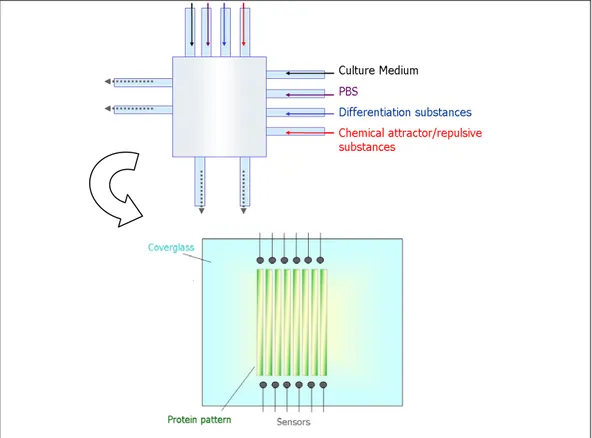Chapter 5
CONCLUSIONS AND FUTURE WORK
5.1 CONCLUSIONS
Starting from the technology used by Chung and colleagues [1], a microfluidic chip, able to generate complex and stable biomolecule gradients, was designed, fabricated and tested. The chip had a well defined chamber surrounded by inlet and outlet microfluidic channels. Thanks to the successfully implementation of multi layer soft lithography, inlet microchannels were provided with active valves. Microchannel dimensions (10 μm wide, 2.5 μm tall) and the maximum operating frequency (∼3 Hz) resulted in single fluid ejection of less than 1 nl/s. Automatic and remote control of valve opening and closing allowed pulsating fluid ejections creating stable biomolecule gradients. The layout of inlet channels, placed on 2 consecutive sides of the square chamber, allowed the composition of user-defined 2D concentration gradients. A complex concentration gradient, obtained by the superimposition of two gradients generated by two orthogonal inlet channels, was successfully demonstrated.
Cell viability inside the chip was observed for five hours time period, revealing the possibility of using this system with fast responding cell types such as those involved in immune response [2]. This result represents an optimal starting value for seeding cells for short term experiments.
The second part of this work was related to the micro-contact printing of fibronectin on glass. Once optimised, this procedure turned out to be reliable and reproducible. The areas where fibronectin was not deposited were passivated with PLL-g-PEG and they demonstrated an
Conclusions and future work
efficiency in avoiding cells from adhering. Two cell types were used and in both cases the protein pattern was stable for three days from culture. It was observed that patterns wider than 10 μm were necessary in order to obtain an efficient cell immobilization.
5.2 FUTURE WORK
The objectives of future work in this area will be to develop a microfabricated test platform that combines hybrid technologies (multi layer soft lithography, micro-contact printing, surface nanoimprinting, and microelectrode deposition) in order to mimic cell microenvironment and provide chemical, physical and electrical stimuli for fundamental cell biology experiments (figure 5.1).
Figure 5. 1 Integration of microfluidic gradient generator with patterned substrate and sensors for signal recording.
Conclusions and future work
The first step will be to combine the developed microfluidic platform with the micropatterned substrates here presented. This device will be used to test the competitive effect between biomolecule gradients and micro-patterned protein immobilized onto the substrate where cells adhere [3]. Subsequently, the microchamber substrate could be also physically patterned thus allowing the realization of relevant biological experiments involving, simultaneously, chemical and physical stimuli.
Considering recent advances in microelectrode deposition on polymer substrate [4], the cell microchamber could be provided also with microelectrode for electrical stimuli.
Developing a microfabricated cell environment that provides a wide range of stimuli (chemical, physical, electrical) will be an enabling technology for advanced studies in several research fields like biology, biotechnology, diagnostics, tissue engineering and therapeutics. Moreover, it will be technically possible also to create a single cell device able to carry out a wide range of subcelluar experiments with high spatial resolution and high sensitivity.
Conclusions and future work
101
REFERENCES
[1] B. G. Chung, F. Lin and N. L. Jeon, A microfluidic multi-injector for gradient generation, Lab Chip, 6(6):, 764–768, 2006.
[2] P. Alstergren, B. Zhu, M. Glogauer, T. W. Mak, R. P. Ellen, J. Sodek, Polarization and directed migration of murine neutrophils is dependent on cell surface expression of CD44, Cell. Immunol., 231(1–2): 146–157, 2004. [3] C. J. Wang, X. Li, B. Lin, S. Shim, G-L Ming and A. Levchenko, A microfluidic-based turning assay reveals complex growth cone responses to integrated gradients of substrate-bound ECM molecules and diffusible guidance cues, Lab Chip, 8: 227-237, 2008.
[4] K. S. Kim, Y. Zhao, H. Jang, S. Y. Lee, J. M. Kim, K. S. Kim, J. H. Ahn, P. Kim, J. Y. Choi and B. H. Hong, Large-scale pattern growth of graphene films for stretchable transparent electrodes, Nature, 457: 706-710, 2009.
